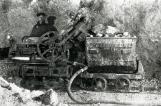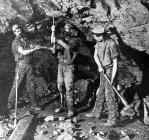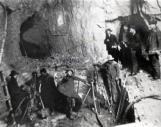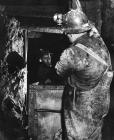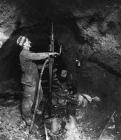15
Mucking MachineMechanical mucking units meant increased efficiencies. More material could be picked up in a shorter time which meant faster advances in tunnels and more production.
17
Hand DrillingInitial mining in Cobalt was done by hand steeling which involved a drill steel being struck by a sledge hammer to make a hole. This was rapidly superceded by machine drilling as the mines developed. Hand steeling continued to be used by prospectors as it was efficient in the bush when there were no power sources available. Competitions were held for many years between miners with hand steel to earn bragging rights. A good crew of two could drill a hole forty inches deep in fifteen minutes with a hammer strike rate of some 60 blows per minute or faster.This would only be done in competition due to the exertion required.
19
Stope and TunnelAs mechanization increased, excavations could be increased in size and developed faster. This led to bigger shafts and lower grade material mined. Notice the bucket at the top of the picture.
21
Hoist and MinersMiners began traveling in cages rather using ladders to go into the mine. This led to increased time spent on actual work instead of travelling.
23
Stope DrillingMining of the steeply dipping silver veins was done with stoper drills which drilled an eight foot hole vertically. Initially these drills did not use water and generated a lot of dust which led to breathing problems for the operators when used for any length of time.
25
Leyner DrillLeyner drills were used in tunneling. These drills were mounted on an arm which in turn was connected to a bar braced between the floor and the back of the drift. Due to the weight of these machines at least two men were required to set them up and operate. The drills were capable of drilling at least a five foot hole up to two inches in diameter.
26
Lyner Drill, Silver Miller Mine1920
Cobalt Mining Camp, Town of Cobalt and Coleman Township, Ontario, Canada

27
Leyner Drill, Silver Miller MineOver the years the Leyner drill was made lighter but was still a two man job to run, particularly in confined areas. The bar was tightened up by means of a screw jack to avoid movement .
